Watershed Appreciation – Get to Know the Anaheim Bay/Huntington Harbour Watershed
January 28, 2022
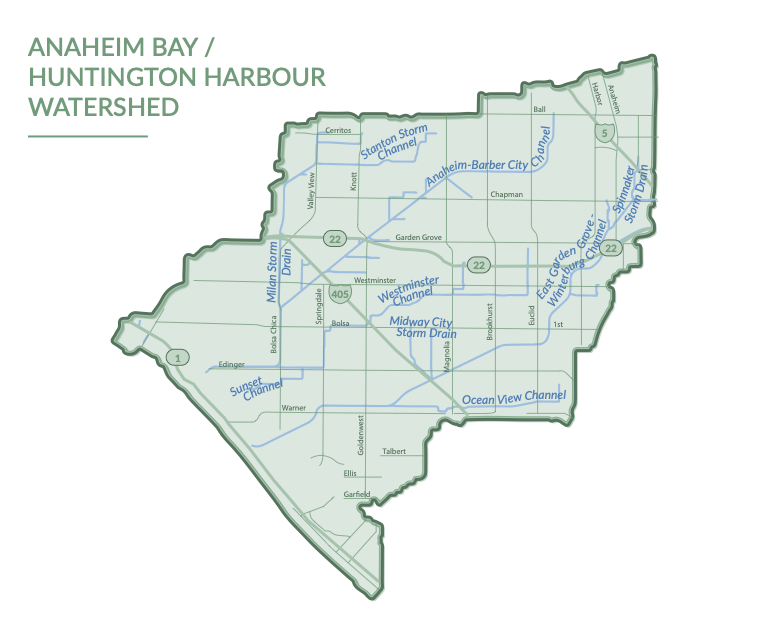
From the serene Pacific Ocean to the towering Santa Ana Mountains, all of Orange County is located in a watershed. No matter if you’re hiking through Bolsa Chica Ecological Reserve, golfing at Mile Square Regional Park, or spending the day at Huntington Central Park, you’re enjoying the Anaheim Bay/Huntington Harbour Watershed’s resources.
Pollution can harm our local creeks, rivers, and the ocean, so it’s up to all of us do our part in protecting OC’s watersheds. Simple actions such as picking up after your dog, throwing away food wrappers, and properly disposing of cigarette butts helps prevent this waste from flowing untreated through storm drains into our waterways.
The Anaheim Bay/Huntington Harbour Watershed is the sixth in a series of blogs that showcase the wonders of each of the 11 watersheds in Orange County. If you’re new to the concept of watershed appreciation, our What is A Watershed? page is a great place to get started. Learn more and find out which watershed you live in by visiting our interactive map.
From unique features and recreational opportunities, to pollution prevention and stormwater resources, it’s time to take a deep dive and get to know the Anaheim Bay/Huntington Harbour Watershed!
WONDERS OF THE ANAHEIM BAY/HUNTINGTON HARBOUR WATERSHED
Unique Features
The Anaheim Bay/Huntington Harbour Watershed covers over 80 square miles and encompasses all or parts of the Cities of Anaheim, Cypress, Fountain Valley, Garden Grove, Huntington Beach, Los Alamitos, Santa Ana, Seal Beach, Stanton, and Westminster. This watershed boasts beautiful undeveloped areas with flourishing ecosystems, like the 1,300 acre-Bolsa Chica Ecological Reserve and 965-acre Seal Beach National Wildlife Refuge. The Bolsa Chica Ecological Reserve has several trails ready to be explored, and the Huntington Beach Municipal Pier is one of the largest piers on the west coast! We can all commit to protecting these unique areas within our watersheds.
Wildlife & Plants
The Anaheim Bay/Huntington Harbour Watershed is home to many rare species too! The Seal Beach National Wildlife Refuge is a vital habitat to several endangered species, including two federally endangered species: the California least tern and the light-footed clapper rail. The California least tern can be found nesting on an artificial island previously used for rocket testing during the Apollo space program. The light-footed clapper rail nests on specially manufactured rafts constructed and maintained by U.S. Fish and Wildlife Service staff with the help of local volunteers.
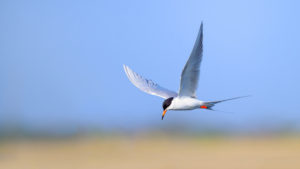 California least tern flying.
California least tern flying.
Eelgrass dominates this refuge, along with sea lavender and salt grass. There are also rare flora and fauna in the Bolsa Chica Ecological Reserve, such as the two-striped garter snake (Federal and California Species of Special Concern), wandering skipper butterfly (Federal Species of Special Concern), and southern tarplant flower (Federal Species of Special Concern).
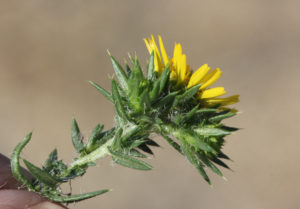 Southern tarplant.
Southern tarplant.
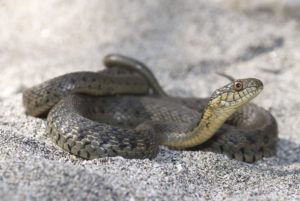 Two-striped garter snake slithering along.
Two-striped garter snake slithering along.
Species common throughout the watershed include the American coots (bird), cottontails (rabbit), and California lilacs (flower). Preventing runoff pollution is vital to protecting the watershed’s flora and fauna.
Recreation
The Anaheim Bay/Huntington Harbour Watershed has wonderful outdoor recreation opportunities for activities like hiking, sunbathing, surfing, volleyball, and bird watching. Visitors and locals alike can enjoy this watershed’s recreational areas, including:
- Huntington Beach Municipal Pier – At a whopping 1,850 feet, the Huntington Beach Municipal Pier is one of the longest piers west of the Mississippi. Go for a stroll and see people fishing, hear the crashing waves, and catch the sunset while over the water. Don’t forget to snap a photo at one of the most Instagram-able spots in the watershed and include #H2OC in your posts!
 Huntington Beach Municipal Pier at sunset.
Huntington Beach Municipal Pier at sunset.
- Huntington Central Park – This 350-acre park is the largest city-owned park in Orange County. Take your kids to one of the largest children’s libraries on the west coast, go for a walk, take a bike ride around Huntington or Talbert Lake, or have a picnic on one of the large open grass fields. With a fishing license, you can also catch channel catfish, largemouth bass, bluegill, and more. Both the east and west sides of the park have plenty for you to enjoy!
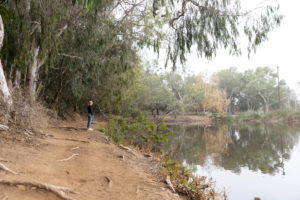 Trail around Huntington Lake at Huntington Central Park.
Trail around Huntington Lake at Huntington Central Park.
- Bolsa Chica Ecological Reserve – This 1,300-acre coastal estuary is made up of open water, marshes, hiking trails, and more. Bring your family on a free tour on the second Saturday of each month or explore the 4-mile trail network on your own. The trails are open from sunrise to sunset every day and the Interpretive Center from 9:00 A.M. – 3:00 P.M., seven days a week too. Be sure to stop at the scenic overlooks and see how many birds you can spot!
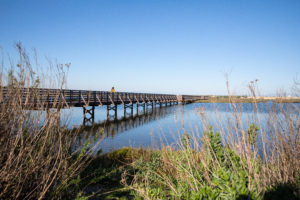 Wetlands at Bolsa Chica Ecological Reserve.
Wetlands at Bolsa Chica Ecological Reserve.
- Mile Square Regional Park – This 607-acre Orange County-owned park in Fountain Valley is full of recreational opportunities. Go fishing in one of two lakes, ride your bike, go on a paddle boat, or learn archery. You can even play a round of golf at one of two courses in the park!
- Huntington Harbour – Explore the harbour by renting a boat, going stand-up paddleboarding, or kayaking! This harbour has 5 artificial islands with over 500 picturesque homes of different shapes and sizes to appreciate. Get your grub on at one of the local restaurants or breweries as you catch a sunset here!
- Haster Basin Recreational Park – This recently renovated park and flood-control facility in Garden Grove is a great spot to appreciate the watershed. There is space for the whole family including soccer fields, barbeque grills, jogging trails, and covered spaces overlooking the lake.
Water Quality
To protect water quality, the Santa Ana Regional Water Quality Control Board regulates the Anaheim Bay/Huntington Harbour Watershed through Municipal Separate Storm Sewer System (or MS4) Permit standards. In this watershed, H2OC is keeping their eyes on pollutants like trash, metals, pesticides, and bacteria, as well as pH levels to ensure the aquatic life can continue to thrive. Due to the implementation of best management practices (BMPs), these pollutant levels have been significantly reduced over the last 15 years.
Some of the BMPs implemented to help meet water quality objectives include:
- Sweeping away bird waste from the beach
- Providing plastic dog waste bags at the beach
- Prioritizing low impact development
- Covering trash cans
- Diverting dry weather urban runoff to the sanitary sewer where feasible
- Installing screens in storm drains that catch trash (catch basin inserts)
- Using devices which filter out debris from stormwater (CDS units)
- Putting floating foam logs in channels to contain trash (trash booms)
- Utilizing trash skimmers (street sweepers for waterways) in Huntington Harbour
The County of Orange, Orange County Flood Control District, and cities in this watershed are committed to protecting water quality for years to come. An exciting project demonstrating this commitment is the City of Anaheim’s Modjeska Park Underground Stormwater Detention and Infiltration System. The main goal of this project is to capture and prevent both urban and stormwater runoff from flowing into the Bolsa Chica Channel and eventually our ocean. It uses an existing 37,000 square foot parking lot to capture and infiltrate 182-acre feet of runoff into the City’s groundwater basin each year for treatment and reuse. That’s equivalent to the average annual water usage of over 2,000 households!
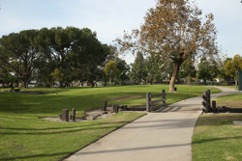 Greenery at Modjeska Park in the City of Anaheim.
Greenery at Modjeska Park in the City of Anaheim.
Another terrific project in this watershed is Harriet M. Wieder Regional Park in the City of Huntington Beach which includes a 4 acre developed park that was designed with a bio-swale system to capture rain and excess irrigation water on-site to replenish groundwater.
 Man running through Wieder Regional Park in the City of Huntington Beach.
Man running through Wieder Regional Park in the City of Huntington Beach.
In drought-prone Southern California, replenishing groundwater is critical to protecting our water supply long-term and can also improve water quality in Orange County’s creeks, rivers, and ocean.
Protecting the Anaheim Bay/Huntington Harbour Watershed
Knowing that metals, pesticides, and bacteria are the most prevalent pollutants in the Anaheim Bay/Huntington Harbour Watershed, below are ways you can prevent pollution to keep the watershed healthy:
Reduce Runoff & Potential Sources of Metals
- Replace your worn-out brake pads with ones that are copper-free.
- Inspect your vehicle frequently to make sure there are no oil leaks.
- Wash your car at a commercial car wash instead of in your driveway.
- Keep scrap parts or other used metals indoors or stored under cover.
- Reduce runoff by regularly checking for leaks and aligning sprinkler heads.
- Use non-copper anti-fouling paint on the hull of your ship or boat.
Properly Dispose of Toxic Materials (like Household Hazardous Waste)
- Motor oil, batteries, and paint should be taken to a Household Hazardous Waste Collection Center (HHWCC) for proper disposal. For a complete list of items that must be disposed of at a HHWCC, click here.
- To find a Household Hazardous Waste Collection Center near you, click here.
Minimize the Use of Pesticides
- Use Integrated Pest Management (IPM) to combat pests. IPM includes using beneficial insects, trapping (such as bait stations), weeding, and other techniques to control pests.
- Avoid using chemical pesticides if possible.
- Do not apply pesticides within 48 hours of predicted rain.
- If you must apply pesticides, only do so during dry conditions with little wind, use the least amount of product possible, and follow the manufacturer’s instructions.
More Ways to Appreciate Orange County’s Watersheds
There are many ways to get involved in your local community and appreciate your local watershed:
- Explore your watershed and report water pollution. While you’re visiting Orange County’s creeks, trails, and coastline, make observations about water quality conditions. If you see anything abnormal (such as high numbers of dead fish or fowl, oil spills/sheens, leaking barrels, or other signs of pollution), report it by visiting our Report Pollution page.
- Connect with area watershed organizations through local events. Join H2OC, other organizations, and your neighbors who are working to protect and restore our creeks, rivers, bays, and ocean. Find events in your area.
- Spread the word. To protect our waterways, share your knowledge about preventing water pollution and encourage others to do the same. You can even involve your kids in learning about watersheds and pollution prevention through our Stormwater 101 for Students page.
- Learn more. Visit our What is a Watershed? page and our Tips for Protecting Your Watershed brochure.